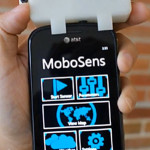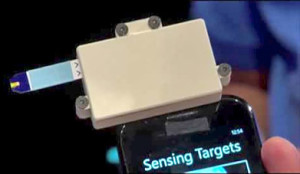Since MoboSens won the Vodafone Americas Foundation Wireless Innovation Project (WIP) in 2013, the startup has made huge progress developing its mobile phone sensor technology for water testing and expanding its uses even further. Mobosens has also partnered with major environmental organizations to apply its technology not only in the developing world, but also in the U.S. Midwest. Our blog post in August of 2014 detailed how far the company had come in only a year.
 As we head into 2015, the company continues to make great strides to help enable citizen scientists around the world in their efforts for cleaner water. In the past six months, MoboSens designed, manufactured and tested its multiplexed water sensors for nitrate, nitride, ammonia and phosphate for mobile phones. The company also worked on improving the sensor storage condition in the sensor to prolong the sensor’s lifetime. In addition to these technology developments, MoboSens is gaining traction in mobile phone sensor use in the U.S. Midwest and is exploring the application of the company’s technology in the medical field.
As we head into 2015, the company continues to make great strides to help enable citizen scientists around the world in their efforts for cleaner water. In the past six months, MoboSens designed, manufactured and tested its multiplexed water sensors for nitrate, nitride, ammonia and phosphate for mobile phones. The company also worked on improving the sensor storage condition in the sensor to prolong the sensor’s lifetime. In addition to these technology developments, MoboSens is gaining traction in mobile phone sensor use in the U.S. Midwest and is exploring the application of the company’s technology in the medical field.
Water Testing in the Midwest
 In the next six months MoboSens plans to have more than 1,000 active citizen scientists in the U.S. using its technology to crowd source nitrate contamination data and to publish quantitative nitrate and phosphate distribution maps online. Through its partnership with the National Great River Research and Education Center (NGRREC), MoboSens produced thousands of nitrate sensing units for the organization’s water scientist and testing volunteer network to perform large-scale, crowd-sourced mobile water testing this last summer. The data gathered from the sensing units is being used to improve the company’s sensor technology. Additionally, many environmental and agricultural NGOs and private companies in the region are beginning to establish strategic relationships with MoboSens to disseminate its mobile phone water sensor products. Because of this surge of interest, the company plans to produce more multiplexed water sensor chips and prepare for field testing this spring.
In the next six months MoboSens plans to have more than 1,000 active citizen scientists in the U.S. using its technology to crowd source nitrate contamination data and to publish quantitative nitrate and phosphate distribution maps online. Through its partnership with the National Great River Research and Education Center (NGRREC), MoboSens produced thousands of nitrate sensing units for the organization’s water scientist and testing volunteer network to perform large-scale, crowd-sourced mobile water testing this last summer. The data gathered from the sensing units is being used to improve the company’s sensor technology. Additionally, many environmental and agricultural NGOs and private companies in the region are beginning to establish strategic relationships with MoboSens to disseminate its mobile phone water sensor products. Because of this surge of interest, the company plans to produce more multiplexed water sensor chips and prepare for field testing this spring.
Mobile Biofluid Sensing
MoboSens has been able to expand uses for its multiplexed water sensor technology to biofluid sensing, e.g., blood glucose sensing. The existing microelectrochemical sensor can be modified for use for biofluid sensing, especially for small-molecule biomarker sensing for glucose, cholesterol, triglyceride and creatinine in blood. In the first half of 2015, the company plans to demonstrate both blood protein sensing capability in the field and reliable blood glucose sensing functionality.
For more information about what the company is up to, visit the MoboSens website, and be sure to check back with us here for more updates on all our WIP winners.

